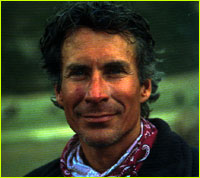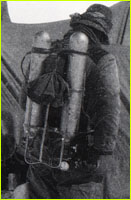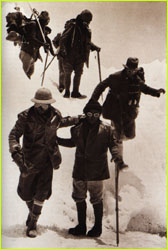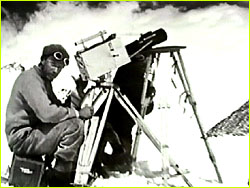 |
 Hear Breashears via RealAudio: 28.8 | ISDN |
 |
The following commentary from veteran filmmaker and mountaineer David Breashears was excerpted from an interview conducted by Andrew North of THE WORLD. QUESTION: How likely do you think it is that Mallory and Irvine could have made it to the summit? BREASHEARS: The ridge they would have followed that day is what we refer to as the Second Step. A lot of the climbing that day is horizontal; you're moving sideways as you head toward the summit of Everest. And it's been likened to trying to walk sideways across a low-angle slate roof: very awkward, not technically difficult, just insecure climbing. Along that ridge at around 28,700 or -800 feet, is a barrier of rock referred to by the British in the '20s as the "Second Step" because there's a bump along the ridge earlier called the "First Step," which you can avoid. There's no way around the Second Step. It is a 25- to 30-foot-high wall of rock, almost vertical, with a wide crack in the back—not wide enough to get into and use a technique we call a chimneying. The climbers of the day in the '20s would have been tied together by just a traditional wound rope. They would not have been carrying the things we use today to anchor themselves to the mountain in a safe and secure way.
But the beautiful thing about this whole mystery and about climbers is something we call the human spirit. And there is a crack in the back, and Mallory was a talented rock climber. Could he have been possessed of such a desire and will to make the summit as to extend or be invested with abilities beyond those he normally possessed to surmount that rock step and get on top? Well you can't say he couldn't have done it, because it is not blank. It is climbable. It is not a vertical wall as smooth as a typical concrete wall. It has features. QUESTION: If they did manage to reach the summit of Everest in 1924, what does that matter? And in a way, does it really change anything? Because after all, Hillary and Tenzing did reach the top and they got down. | ||||
|
28.8 | ISDN |
BREASHEARS: I can tell you that at least in mountaineering circles, it would be a monumental and almost in a way a traumatic occurrence, should they find the camera and find a photo of Mallory or Irvine on the summit. Hillary did make a very good point when we interviewed him years ago about this. It's not only the getting up that's important, it's the getting down that's important. But first of all, it would raise our respect and almost sense of awe of what those early climbers achieved another notch. It would be miraculous. QUESTION: Could you compare those early climbers to today's climbers—their skills and their equipment, and how they achieved great things? | |||||
|
28.8 | ISDN |
BREASHEARS: When we modern climbers are going out on these great peaks, 60, 70, now 75 years after Mallory and Irvine perished, we really hold these climbers in awe and have great respect and admiration for them. They had a certain character; I don't think it's any more remarkable than many of the climbers that are out there today. They were ordinary flesh and blood, let's remember that. They weren't extraordinarily tough, they weren't extraordinarily strong, but they had I guess you could say the right attitude.
It's worth remembering that high on Everest—Everest is the same latitude at Ft. Lauderdale—in late May or early June when they were high on the mountain, that sun is directly overhead. And there's not a lot of atmosphere to filter out the radiant power of that sun. And when it's windless and clear high on Everest, many times I've had to unbutton and take off my down suit and open my pile jacket to be able to climb. There are moments of incredible wind and cold on Everest, and those men would have frozen to death in the '20s in a matter of hours. But there are moments when it's pleasantly warm high on Everest. I know this kind of takes away from everything associated with being on top of this great icon. So that's a very long way of saying they had poor equipment, they had the right spirit, but they were of the same flesh and blood. The thing you have to remember they had going for them—and this is an important thought I'd like to point out—it's the same thing Hillary had going for him with Tenzing and Hunt and the whole team in 1953. They had the privilege of the motivation of being able to be first. And that is, for certain individuals, something that you look for and something that motivates a person, that doesn't frighten a person. So although they had inferior gear, they had the motivation and drive and the privilege of being the first people on certain routes, and every step you took was the highest a man had ever been on the surface of the Earth. I'd have to look into the balloon flights back then and aerial flights, but no one had been that high. So it's an interesting mix here of poor gear but a sense of mission, a sense of privilege to be able to be first, and that motivates a person tremendously. QUESTION: You've now climbed Everest four times. When you've been on your various climbs of the mountain, have you found yourself thinking about them, about Mallory and Irvine and what they might have achieved all those years ago? | |||||
|
28.8 | ISDN |
QUESTION: Do you think that this team now at the base of Everest and soon to be heading up on the mountain should be trying to solve this mystery or is it best to just let this one live on as a mystery? | |||||
|
28.8 | ISDN |
BREASHEARS: I could romanticize the fate of Mallory and Irvine and say, "Let them rest. Why do we need to know?" On the other hand, I can understand the need to know, because this isn't really about finding their bodies. It's about finding the camera, which you can't find probably without finding the bodies. And it's just natural human curiosity, because we have such respect for these men that we actually think—I'm willing to say there is a slight possibility they could have made it. But there are people who really would like for them to have made it and want to know if they made it or not.
Back to The Mystery of Mallory & Irvine '24 Photos: (1) R. Schauer; (2,3) Finch Collection, courtesy of Mrs. Scott Russell. Lost on Everest | High Exposure | Climb | History & Culture | Earth, Wind, & Ice E-mail | Previous Expeditions | Resources | Site Map | Everest Home Editor's Picks | Previous Sites | Join Us/E-mail | TV/Web Schedule About NOVA | Teachers | Site Map | Shop | Jobs | Search | To print PBS Online | NOVA Online | WGBH © | Updated November 2000 |
|||||
 David Breashears
David Breashears
 Early oxygen tanks were heavy and unreliable.
Early oxygen tanks were heavy and unreliable.
 Everest's conditions are brutal even with today's climbing equipment. The gear of 1922 offered less protection to the few who challenged the summit (Geoffrey Bruce and George Finch).
Everest's conditions are brutal even with today's climbing equipment. The gear of 1922 offered less protection to the few who challenged the summit (Geoffrey Bruce and George Finch).
 Captain John Noel, Everest's first cinematographer
Captain John Noel, Everest's first cinematographer
